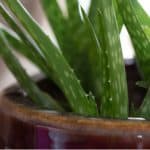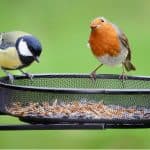Last updated on March 16th, 2022
Our site is reader supported, this means we may earn a small commission from Amazon and other affiliates when you buy through links on our site.
When you try to attract birds to your nest box you have to start by determining which materials are most appropriate, whether you are building or buying, and then attach the box to the most appropriate part of your garden be it on a wall, fence or tree.
Choosing the Right Bird Box
Bird boxes and nesting holes are not standardised because there are so many different birds of various sizes that might frequent your garden. If you want to provide a nest for Great Spotted Woodpeckers or Starlings you will need a larger nest box compared to boxes for other birds such as Blue Tits.
The bottom of the entrance hole needs to be, at a minimum, 125mm from the floor of the nest box, otherwise smaller birds could simply be scooped out by predators. The inside wall below this entrance hole needs to be a tough material so that the younger birds are able to climb up it when they need to leave the nest box. If you are making or buying your box be sure that you don’t invest in pressure-treated timber because these contain leachates that can be harmful to the birds.
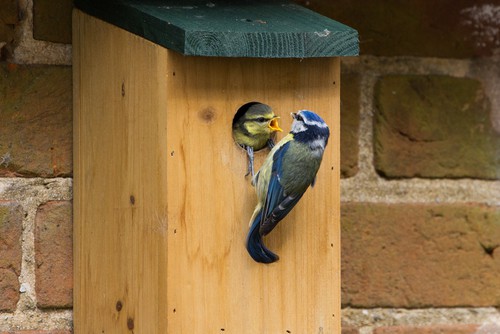
Don’t use pressure treated timber, use water-based preservatives instead
When you put your nest box in place you should always leave the box untreated. If you have treated it beforehand, make sure it properly dries out from any water-based preservatives you might have applied before you put it out in the garden.
Drill holes in the bottom of the nest box if there aren’t any
There should be drainage holes at the base of your nest box and everything should be assembled with galvanised screws or nails.
Bird oxes for woodpeckers
If you are providing a nest box for woodpeckers you will need to fill the box with wood chips or rotting logs. Woodpeckers prefer to excavate the nesting cavity themselves. You should prepare yourself for cleaning out this box each winter (or autumn) so don’t nail down the lid but rather attached it with a hinge that won’t rust, and fasten it in place so that you can open and close it when necessary. If you are purchasing a bird box also look for one that you have access to for the same reason.
Find a bird box with a suitably sized hole
In terms of size, the entrance hole should be 25mm if you are attracting any type of Tit. If you are attracting Tree Sparrows it should be 28mm, if you are attracting House Sparrows or Nuthatches go for a 32mm entrance, and 45mm for Starlings. Boxes that have an open front of 100mm are best for Robins and Pied Wagtails.
Where Should you Position Bird Nest Boxes?
Position it at the correct height
When you are positioning your bird box you need to consider the type of bird you are attracting. If you have a box for sparrows, starlings or tits, the box should be placed between 2 and 4 metres up a wall or a tree. If you are placing a box for house sparrows it should be high up under your eaves. These birds typically nest in smaller colonies so you can place two or three nest boxes spaced out on the same side of your home, as long as you keep them away from any place on your property where housemartins normally frequent.
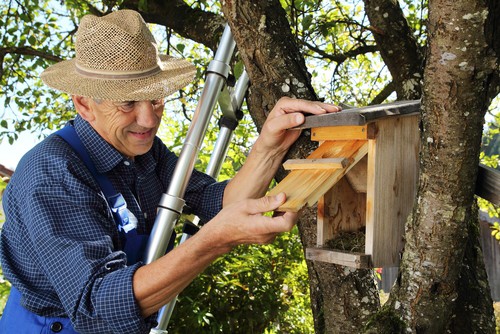
Avoid positioning them in areas that get strong winds or very wet weather
You should avoid placing your nest box anywhere that is exposed to strong sunlight or very wet winds. It should face between the North and the East if at all possible. Your birds need to have a clear flight path without any type of clutter blocking the entrance. The box should be tilted forward ever-so-slightly so that if any rain hits the roof it will bounce off.
Attaching a Nest Box to a Fence, Wall or Tree
Use wire to avoid damaging trees
Once you have selected the right area it’s time to attach your nest box. Bear in mind that should you attach the nest box with nails it will cause damage to the tree, the fence or the wall. If you are bolting your nest box to a tree it is better to use wire to wrap it around the trunk if you want to prevent damage. Of course, you will also have to check on the wiring every two or three years because trees not only grow taller but grow thicker and the wire could eventually damage the tree.
The same can be applied to the walls of your house or fences in your garden. You can use nails to affix it most securely but if you don’t want to damage the wall or the fence you can always use wiring to secure it in place, where possible.
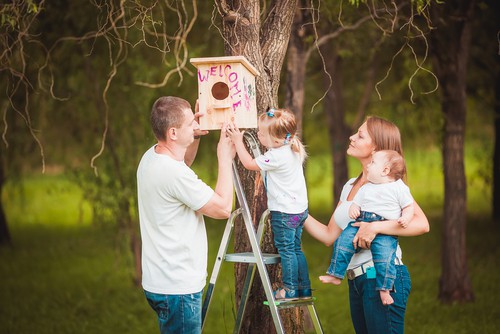
Positioning a nest box for Robins and Woodpeckers
If you are attaching an open-fronted nest box for Robins you need to place it low to the ground, hidden in vegetation. This might be against a fence within shrubs or in a tree.
If you are putting in a nest box for spotted flycatchers you will need to place it (on average) 3 metres high but it needs to be sheltered by vegetation against the fence, wall, or tree. Woodpeckers need a box that is higher on a tree trunk specifically.
No matter where you attach the nest boxes, they are best to put up in the autumn so that birds can enter them during this time when they looking for a place to roost. Most birds will return to the same box for nesting the following spring if they find the accommodation to their liking.

